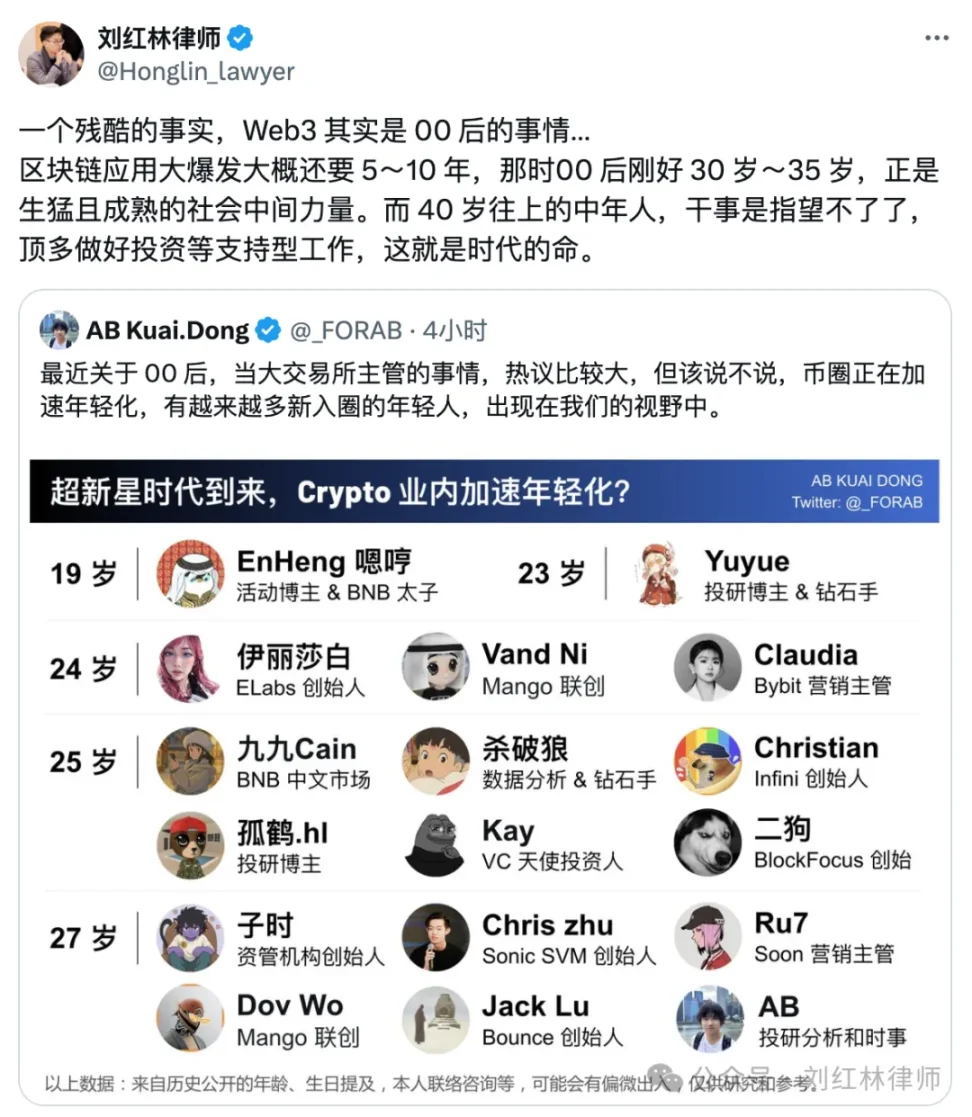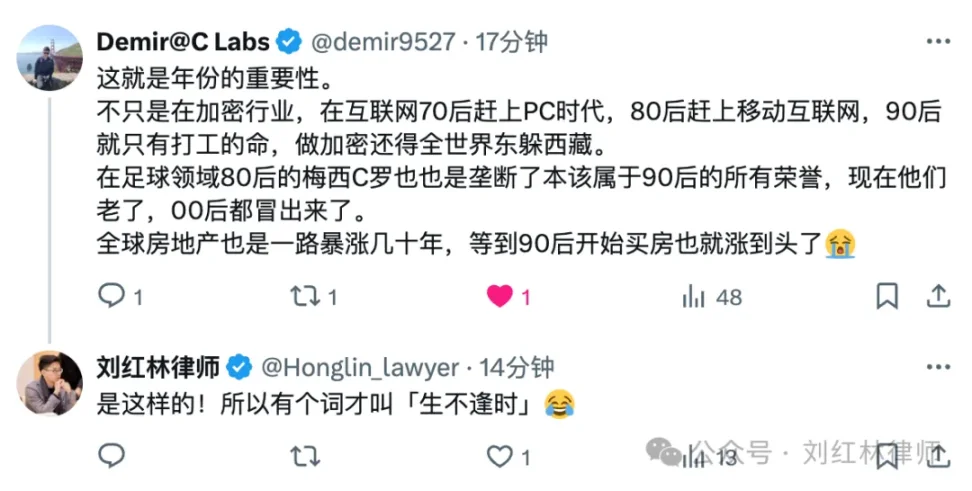In this generation of young people, Web3 is not a transformation, but a vocation.
Written by: Liu Honglin
In the crypto industry, "youth" is no longer just a label, but a reality.
While surfing the internet, Lawyer Honglin saw a list of "young faces in the crypto industry" circulating on social media. From BNB, SVM to Infini, from researchers to VCs, from exchange operators to meme community founders, the list is filled with people in their twenties. The youngest is 19, and the oldest is only 27. They are not only the spokespersons for projects but also the narrative leaders, community organizers, and even capital coordinators.
Lawyer Honglin couldn't help but exclaim: "A harsh reality is that Web3 is actually a matter for the post-00s…"

Why did "young people" win this competition?
This is not an emotional remark, but a calm and serious temporal deduction. According to the current disappointing development pace of the industry (especially the Ethereum stablecoin projects), if the blockchain industry truly wants to usher in a massive application explosion, optimistically, it will take another 5 to 10 years—by then, the post-00s will be 30 to 35 years old, which is the vigorous and mature golden age with both technical and resource capabilities. And what about the post-80s and post-90s? Most of them have already passed the stage where they can compete, whether in terms of physical or mental strength. If they still want to stay relevant in the industry, they are likely to only transition to becoming investors or rely on years of experience to contribute skills like workplace werewolf games or drama, leaving them with fewer opportunities to charge into battle.
The reason is: today's Web3 is no longer an industry that wins positions through experience, but one that relies on discourse power, community perception, and information sensitivity. And these are often not in the hands of the older generation.
The young people on the list almost have no labels of "traditional finance" or "big internet companies." You could interpret this as a lack of social experience, but you could also say they have no path dependency or toxic legacy. They are not transitioning from Web2 to Web3; they are born "on-chain." Among this generation of young people, Web3 is not a transformation, but a vocation.
They started investing in projects, becoming KOLs, and building communities while still in college. Their understanding of the on-chain game rules, marketing techniques, data rhythms, and ecological interactions far exceeds that of the "veterans." They carry no burdens, possess their own discourse system, dare to speak and try, and even enjoy charging into the fray and stepping on landmines. The technical abilities and market instincts of this generation are truly native "on-chain species."
More importantly, they have formed a new trust system and collaboration method among themselves. It is not based on "apprenticeship" or "platform blood transfusion," but on friend circles, TG groups, RedBook dynamics, and the ever-changing narrative of meme culture. This mode of cooperation is difficult for older individuals to integrate into, or even understand.
The older generation of Web3 practitioners: the fate of passive "overtime"
If you are a post-80s or post-90s practitioner in Web3, you may have felt a bit exhausted in recent years: bull markets come one after another, and the technical narrative has shifted from Layer 1 to RWA, and then to AI+Crypto. The pace feels somewhat frantic.
You may have done many "structurally correct" things, such as launching chains, creating wallets, forming guilds, and managing funds, but looking back, the ones who truly captured the market are often a 23-year-old graduate student who created an airdrop bot, token intelligence analysis, or diamond hands community while attending classes.
It's not that you aren't working hard; it's that the rhythm is off. For today's Web3 world, speed trumps scale, traffic trumps foundation, and rhetoric trumps experience. This is not a matter of right or wrong, but a change in the rules.
The technical development of crypto is becoming increasingly modular and productized, reducing reliance on "elite developers"; meanwhile, the complexity surrounding community, traffic, and token economy design is on the rise. Narratives are becoming faster, trends shorter, project lifecycles compressed, and the importance of operational and strategic gameplay is increasing.
This means that the industry's requirements for people have changed. From "being able to do" to "being able to express"; from "technical" to "reactive"; from "accumulating assets" to "creating emotions."
In such an environment, the advantage of youth is not "cheapness," but their shorter feedback cycles, fewer path dependencies, and more flexible social maneuvering. Their "first principles" are social networks, not white papers.
This is not the alienation of Web3, but its original form: an experimental industry that prioritizes community-driven initiatives and consensus building.
The biggest challenge faced by middle-aged individuals is not a lack of ability, but "too high a cost of participation." They cannot stay up all night on Discord, cannot fly three times a week for ecological activities, and cannot turn their social accounts into extensions of their lives. At this point, they can only step back, become angels, engage in investment research, and share industry knowledge. This is also the true meaning behind Lawyer Honglin's statement that "at most, you can do investment support work."

How should the old OGs of Web3 pass the baton?
In 1961, 26-year-old Li Ao wrote "The Elderly and the Baton" in Taipei, critically questioning the older generation in the intellectual community who "neither retire nor take on apprentices, unwilling to pass the baton."
He said: "What young people fear the most is not that you don't give them the baton, but that you hold a baton that has fallen out of use and still want to hit them on the head with it." This statement spans sixty years and still accurately names many "old leeks" and "old-timers" in the Web3 world today.
The baton written by his generation was about academic, political, and cultural intergenerational anxiety. Today, when we talk about "the baton of crypto," we are referring to the real transfer of technical discourse power, traffic organization ability, and community control. The baton is no longer an abstract "ideal" or "tradition," but tangible nodes, tokens, and the influence of industry circles.
Li Ao reminded the younger generation not to overestimate the "desire for legacy" of the elderly—many people can't even hold the baton steadily, and what more they hand over is often just a hollow baton emptied by time, with only a coating left.
They repeatedly claim to support young people, but when it comes to actual resource allocation, project launches, and decision-making, you will find that "support" is merely a posture, and power still resides in their own pockets. "You propose, I decide; you operate, I sign; you charge, I just '+1' in the group." The result is that you think you are in a relay, but in fact, you are just working for them.
So the issue has never been about age, but whether you truly have the awareness and ability to "pass the baton."
Don't forget, every generation of technological innovation will have a group of "behind-the-scenes operators." They do not seek the spotlight but grab resources, control the rhythm, and manage risks. Middle-aged individuals do not necessarily need to compete with the post-00s for traffic, but they can negotiate deals, allocate resources, and ensure minimum standards with them. You may not be able to be a 23-year-old content creator, but you can invest in them, incubate them, and serve them, transforming yourself into a lever and foundation for young people to exert their strength, actively becoming the one who passes the baton.
The truly respectable "crypto elders" are not those who stand in the spotlight pretending to be young, but those who stand behind the stage, allowing young people to truly run. They do not talk about "back in my day," but help them tell "your now." They do not grab the "next baton," but make the "next baton" easier to catch, able to run better, and take fewer detours.
After all, this tide is not a confrontation, but a symbiosis.
This is not a drama of "young people replacing middle-aged people," but a structural change in the Web3 industry from "technology-driven" to "narrative-driven." And the first to perceive and adapt to this change are the new generation of practitioners who are "pushing at 19, writing contracts at 23, and launching projects at 25."
They do not need us to teach them, but we must learn to relearn.
This is the fate of the times.
免责声明:本文章仅代表作者个人观点,不代表本平台的立场和观点。本文章仅供信息分享,不构成对任何人的任何投资建议。用户与作者之间的任何争议,与本平台无关。如网页中刊载的文章或图片涉及侵权,请提供相关的权利证明和身份证明发送邮件到support@aicoin.com,本平台相关工作人员将会进行核查。




